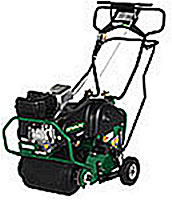

Aerating Your Lawn
There is probably no other process that offers as many benefits to your lawn as aeration. Regular maintenance with mechanical aeration will keep your lawn healthy and green.
Why Aerate
In this area, many of the lawns nutrient rich tops soils have been stripped away during construction or excavation forcing grass to grow in subsoil that is more compact and higher in clay content. Over time, rain, watering, walking, playing and mowing lawns all begin to compact the soil and stress your lawn. Lawns growing in compacted soil have shallow, weak root systems and are thin and yellowish green in appearance. Aeration relieves soil compaction by pulling cores from the soil allowing air and water in. The process stimulates root growth as nutrients begin to enter the soil. The roots will grow deeper and more robust resulting in a healthier stand of grass on the surface.
Thatch accumulation left unmanaged begins to impede water and fertilizers from delivering nutrients to turf roots. Many people will try to mechanically or manually rake thatch barriers which is a very labor intensive and time consuming process that generates a lot of waste. A 10,000 sf. lawn can generate over 24 bags of thatch headed for the landfill. A much easier and quicker solution would be to aerate. Aeration breaks through the thatch barrier and deposits soil cores on the surface of the thatch. The soil releases organisms on the surface and are better able to breakdown the thatch barrier naturally, forming an organic nutrient rich top dressing.
How Often Should Lawns Be Aerated
Most lawns only require annual aeration. Lawns growing in heavy clay or subsoil may need more than one aeration each year.
The Best Time To Aerate
Early spring and fall are generally the best times to aerate, but it can be done anytime the turf is actively growing.
Water!
If the soil is too dry, the tines of the aerator cannot penetrate to a sufficient depth. Core depths should be 2-3 inches deep. If in doubt, we recommend testing the soil by taking a blunt rod or large screwdriver and pushing it into the soil. The screwdriver should easily penetrate the surface approximately 3-6 inches in order for the aerator to be effective. If not, water heavily 2-3 days prior to aeration.
Seed, Fertilizers or Both